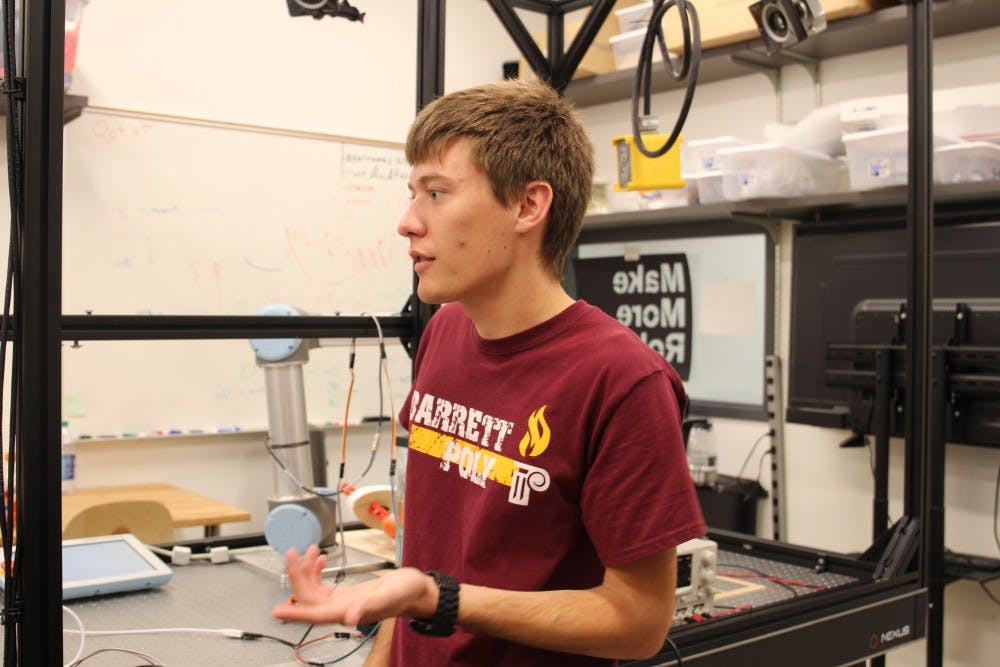Sitting on a table in a lab on ASU's Polytechnic campus is a small robot made of plastic, and it's got one purpose: to jump.
Costing only about $50 to make, this robot is one of a few experiments that researchers at Poly's IDEAlab hope will jump start a movement of young students creating their own robots.
The IDEAlab is helping students focus on designing and analyzing different kinds of robots in order to create engineering solutions to various problems in the robotics field.
This lab opens the door to a wider variety of students who want to work with robots. Most of the lab's creations are made from readily available materials like cardboard and plastic, a stark contrast to the expensive materials typically found in most robots.
Students learn how to utilize the deficiencies of the cheaper materials that they are working with. The materials used in the lab are known for not having a high performance, but they bend and flex in ways that traditional robots do not. The students in this lab use the flexibility of these materials to their advantage in order to learn how these supplies store energy and act as sensors.
The students who are a part of this lab are learning to fuse some of these robots together into higher, better functionalities. Graduate system engineering student Mohammad Sharifzadeh is highly passionate about this research and believes that the IDEAlab has two main goals.
“(The two main goals are) making robots accessible to anyone and exploring methods to make robotics more economical," Sharifzadeh said. "We use foldable robotics techniques, which use low-cost commercial materials to construct robots."
The members of the IDEAlab believe that using cheap materials in robots can help younger students dive into the world of robotics sooner rather than later. The robots these students will use will be more accessible due to the materials costing significantly less.
“Because it’s made out of cardboard and plastic, these robots can be used in education," Daniel Aukes, director of the IDEAlab, said. "They can teach students how to make robots before they even understand how robots work.”
Aukes said that teaching a student how to create a robot makes it easier to teach them the more intricate engineering process.
“The idea is that if you can make a robot in an hour, or a day, or even a week, then you’re able to teach the concepts of robotics without having to have gone through the analytical engineering process that usually takes four years of undergraduate education to get," Aukes said. "We are trying to cut through that time process to motivate students to learn that if they can make a robot but they don’t understand why it did something — then that is a really good question to answer."
Using cheaper materials to build robots has more advantages that go beyond availability to a wider range of individuals. Jacob Knaup, an engineering junior and undergraduate researcher in the IDEAlab, said these simpler robots are faster to prototype.
“Aside from the advantage of being able to turn out new designs more rapidly, foldable robots also offer the potential ability to complete complex tasks using simple devices," Knaup said. "We posit that multiple simpler and cheaper robots are a better solution to most robotics problems than a single more advanced and more expensive robot.”
Another advantage is how the low-cost robots operate completing one function – in a similar way a laser printer scans once to cover an entire space. Following this concept, if one robot happens to work incorrectly or even fails, then it is not expensive to replace.
Some challenges do tend to arise every so often due to the unambiguous nature of the robots’ designs. And sometimes, cheaper materials lead to performance issues. To combat these issues, the researchers use slightly higher quality materials.
Through the IDEAlab lab, the students are developing not only low-cost robots, but methods as well. These students are trying to prove that these low-cost robots can become advanced, high-performing robots. This produces a greater opportunity to expand the accessibility of robotics.
“By providing anyone the chance to make robots, more people will be encouraged to explore their ideas in robotics and make their own dream robots come to reality,” Sharifzadeh said. “I’m sure there will be many valuable and life-changing robots designed and built in the future by non-robotics engineers ... Also, I believe that in the future, the foldable, laminated robots would be a door opening up to a more economical and beneficial field of robotics.”
Reach the reporter at jlmyer10@asu.edu or follow @jessiemy94 on Twitter.
Like The State Press on Facebook and follow @statepress on Twitter.




